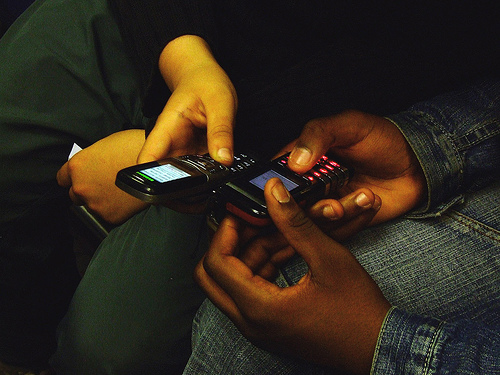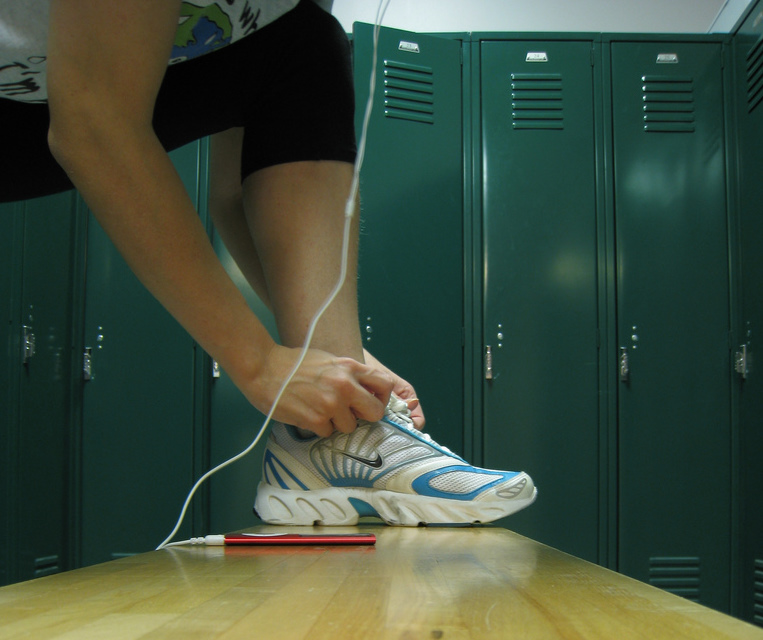Kids and Media Use: Letting their fingers do the walking?

‘Cell phones’ courtesy of JR Paris on Flickr
Seven hours and 38 minutes. It’s how much time you may spend sleeping each night or working each day. It’s also how much time kids ages 8-18 spend on average each day consuming media, such as watching TV, listening to music, and using a computer, according to a new Kaiser Family Foundation (KFF) study.
The study, Generation M2: Media in the Lives of 8- to 18-Year-Olds, reveals astounding numbers that surprised the researchers and created their own media mayhem. Some of the mind-boggling numbers include:
- Of the 7 hours and 38 minutes (7:38) 8-18 year-olds spend on average using entertainment media across a typical day, much of that time is spent ‘media multitasking’ (using more than one medium at a time). The result is that youth pack a total of 10 hours and 45 minutes (10:45) worth of media content into those 7½ hours.
- Black and Hispanic children consume nearly 4½ hours more total media daily (13 hours of total media exposure for Hispanics and for Blacks, and about 8½ for Whites). Black children spend nearly 6 hours and Hispanics just under 5½ hours watching TV, compared to roughly 3½ hours a day for White youth. Differences by race/ethnicity remain even after controlling for other factors such as age, parents’ education, and single vs. two-parent homes.
- Youth ownership of cell phones increased from 39% to 66% over the past 5 years. Ownership of iPods and other MP3 players soared from 18% to 76%.
- This group spends more time listening to music, playing games, and watching TV on their cell phones (a total of :49 daily) than they spend talking on them (:33). (Texting was not measured.)
- Media use increases substantially when children hit the 11-14 year-old age group, to a total media exposure of almost 12 hours per day (vs. about 8 hours for 8-10 year-olds).
“Try waking a teenager in the morning, and the odds are good that you’ll find a cell phone tucked under their pillow–the last thing they touch before falling asleep and the first thing they reach for upon waking.” – Victoria J. Rideout, Ulla G. Foehr and Donald F. Roberts, Generation M2: Media in the Lives of 8- to 18-Year-Olds.
What are the health consequences?
There is already growing concern that this generation of children may be the first in two centuries to have a shorter life expectancy than their parents, fueled by the childhood obesity epidemic. Will even more years be trimmed off due to the increase in media use? Television viewing was found to be associated with an increased risk of death in a recent national study of 8,800 adults in Australia (Television viewing time and mortality). Is this M2 generation destined to live many less hours; with many more of those precious hours spent staring at screens?
The study focused on what kids are spending their time doing: watching TV, playing video games, sitting at computers. But the key issue pertaining to their health and well-being may very well be what they are NOT doing during those 7+ hours each day that they are engaged with a screen.
- They are not having face to face conversations with family members and friends.
- They are not climbing, jumping, or running.
- They are not fully engaging their senses in our 3-dimensional world.
What do we do now?
Technology is here and it’s here to stay. These numbers will increase: the only questions are how fast and how much. The huge increase in cell phone ownership emphasizes the ‘anywhere, anytime’ aspect of media penetration. Sure, it can mean more texting of LOL and OMG in bedrooms and buses across the country. But it also provides an opportunity to reach and educate youth that otherwise might slip through the cracks.
As I’ve discussed previously with respect to the mHealth Summit, mobile technology offers an exciting platform by which to develop new tools and messaging strategies that don’t require a high level of literacy, and to develop programs to increase literacy and knowledge in a targeted, non-stigmatizing, non-threatening manner. The report Pockets of Potential: Using Mobile Technologies to Promote Children’s Learning (PDF) from The Joan Ganz Cooney Center at Sesame Workshop, illustrates how innovative, strategic thinking will help us redefine teaching and learning by harnessing the power of mobile technologies.
“Because I said so!”
This new KFF report clearly highlights the need for parents to…be parents. The data are crystal clear – rules and guidelines work wonders. In the study, only about one third of the youth reported having rules about how much time they can spend watching TV, playing video games, and using the computer. The report shows that when parents do set limits, children spend less time with media: those with any media rules consume nearly 3 hours less media per day than those with no rules.
There are numerous resources available to help parents, including the National Heart, Lung, and Blood Institute’s We Can! Program. Start with a family screen time log, work with your kids to set parameters, set a good example, and press the ‘Off’ button on the TV remote. Teachers may wish to look at Every Waking Minute? Examining Personal Media Habits, from The New York Times blog, The Learning Network.
Exchange screen time for green time.
Kids can’t stare at a screen and their hands aren’t available to text or play video games when they are climbing trees, swinging from monkey bars, building a snowman, splashing in a pool, scaling a rock wall, or digging in a garden. Head outside–whether it’s a backyard or a national park–where there is some combination of sand, rocks, water, mud, and even some odd noises. The hands will start exploring, and soon it will be the senses that are multitasking.











Trackbacks & Pingbacks
[…] Kids and media use: Letting their fingers do the walking? […]
[…] Kids and Media Use: Letting their fingers do the walking? […]
[…] Kids and Media Use: Letting their fingers do the walking? […]
Leave a Reply
Want to join the discussion?Feel free to contribute!